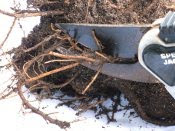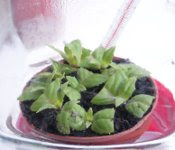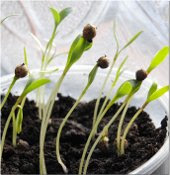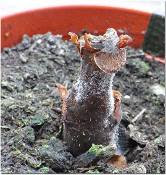 After partially venting the fuchsia cuttings in the coffee jar propagator for a couple of weeks , they should be hardened enough to remove the lid. As you can see, after removing the diseased dead flower buds there is now no sign whatsoever of any botrytis. The cuttings do seem to be growing slowly, though I am not yet sure they will all survive. However, what I cannot understand is that, given what we have seen about the compensation point, how can cuttings even survive for any length of time in a sealed propagator?
After partially venting the fuchsia cuttings in the coffee jar propagator for a couple of weeks , they should be hardened enough to remove the lid. As you can see, after removing the diseased dead flower buds there is now no sign whatsoever of any botrytis. The cuttings do seem to be growing slowly, though I am not yet sure they will all survive. However, what I cannot understand is that, given what we have seen about the compensation point, how can cuttings even survive for any length of time in a sealed propagator?PERMANENT COMPENSATION POINT
When both photosynthesis and respiration proceed at the same rate, there is no sugar left over for plant development (i.e.growth). In a sealed container, photosynthesis (which produces oxygen and uses carbon dioxide) and respiration (which produces carbon dioxide and uses oxygen) must reach an equilibrium point where each complements the other with the necessary gases with which to function. In other words, a sealed propagator must be permanently at compensation point.
This could explain the lack of development of the fuchsia cuttings over the ten weeks they were sealed in the propagator. Any development could well have occurred during the time taken to reach this gaseous equilibrium, or compensation point. Of course, we cannot ignore the fact that temperatures were very low, so even if gas concentration levels were adequate for growth, it would be much reduced anyhow. However, things would be very different in summer when temperatures are higher. This might be why venting seems necessary at this time.




 Raising the heat and lowering the humidity in the propagator creates its own problems. This old begonia tuber (the half tuber which had
Raising the heat and lowering the humidity in the propagator creates its own problems. This old begonia tuber (the half tuber which had 





















